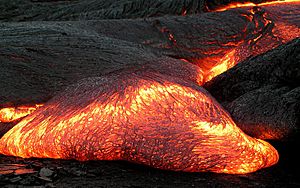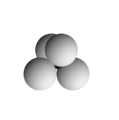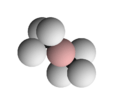Magma facts for kids
Magma is melted rock found deep inside the Earth. Think of it like super hot, gooey liquid rock. When this melted rock stays underground and cools, it forms different kinds of rocks. But when magma comes out of a volcano, it's called lava. Lava cools much faster than magma underground.
There are different types of magma:
- Felsic magma is thick and sticky. It has a lot of a mineral called silica. This type of magma usually forms light-colored rocks like granite.
- Mafic magma is more runny. It has less silica than felsic magma. This type often forms dark-colored rocks like basalt.
- Intermediate magma is somewhere in between. It has properties of both felsic and mafic magma.
Contents
What is Magma Like?
Magma is a very hot liquid. Most magma is between 700°C and 1300°C (that's 1300°F to 2400°F!). It's mostly a mix of different silicate minerals. Even though magma is liquid, most of the Earth's crust and mantle are solid. Magma usually forms in places where it's very hot and the pressure is lower, just a few kilometers below the Earth's surface.
Magma can change its makeup over time. This can happen if different types of magma mix together, or if parts of the magma cool and separate. When magma finally cools down and becomes solid, it forms what we call igneous rock.
Scientists usually study magma by looking at lava that has flowed out of volcanoes. But sometimes, during special drilling projects for energy, they have actually found magma underground! This has happened a few times in Iceland and once in Hawaii.
How Magma Moves
Magma forms deep inside the Earth's mantle or crust when the conditions are just right for rock to melt. Once it forms, magma starts to rise towards the Earth's surface. This happens because magma is lighter than the solid rock around it. It also needs cracks or pathways in the rock to move through.
Magma often gathers in large underground spaces called magma chambers. It can stay in a magma chamber for a long time. While it's there, it might cool down and turn into solid rock, or it might move into another chamber. Sometimes, it erupts out of a volcano as lava.
How Magma Cools and Forms Rocks
Magma cools in two main ways:
- It can erupt from a volcano and become lava.
- It can cool down slowly deep inside the Earth's crust or mantle.
In both cases, most magma eventually cools and hardens into igneous rocks.
When magma cools slowly underground, it forms large bodies of rock called plutons. These rocks are known as "plutonic rocks." Examples include gabbro, diorite, and granite. The type of rock formed depends on what the magma was made of.
If magma erupts from a volcano, it cools much faster. This fast cooling creates "volcanic rocks." Examples of volcanic rocks are basalt, andesite, and rhyolite. These are the surface versions of gabbro, diorite, and granite, respectively.
Images for kids
See also
 In Spanish: Magma para niños
In Spanish: Magma para niños




